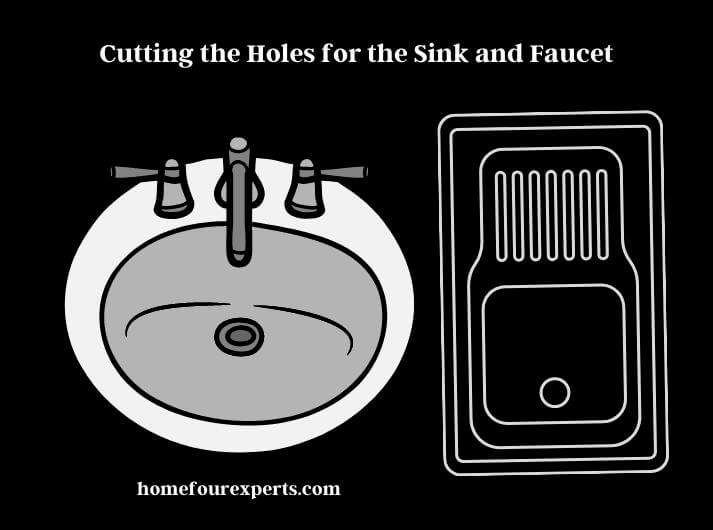Published on: March 10, 2023
Written by Eric Devin / Fact-checked by David Rowan
Upcycling, or the process of repurposing old items into something new and useful, has become increasingly popular in recent years. With concerns over the environmental impact of consumerism and a desire for unique, one-of-a-kind home decor, upcycling offers a sustainable and creative solution.

One popular upcycling project is turning an old dresser into a rustic bathroom vanity. This DIY project not only saves money on the cost of a new vanity but also reduces waste by repurposing an existing item. Plus, a handmade vanity adds character and charm to any bathroom.
Benefits of Upcycling a Dresser into a Vanity
Upcycling a dresser into a vanity offers several benefits, both practical and aesthetic.
Upcycling an old dresser is an eco-friendly and sustainable way to repurpose furniture that may have otherwise been discarded. This reduces the amount of waste that ends up in landfills, contributing to a greener environment.
Upcycling a dresser into a vanity is a cost-effective solution. Purchasing a new bathroom vanity can be expensive, but upcycling an old dresser is a more affordable option. Plus, you can customize the look of the vanity to match your personal style, saving money on the cost of a pre-made vanity that may not fit your aesthetic vision.
Upcycling a dresser into a rustic bathroom vanity adds character and charm to your bathroom. The unique design and character of the dresser add a touch of personality that can make your bathroom feel more inviting and cozy. Plus, the vanity becomes a conversation piece that guests are sure to admire.
Tools You Will Need to Turn an Old Dresser into a Rustic Bathroom Vanity
To turn an old dresser into a rustic bathroom vanity, you will need a few essential tools. Here’s a list of the tools you will need to complete this DIY project:
- Tape Measure: A tape measure is essential to measure the size of your bathroom and ensure the dresser you choose fits perfectly.
- Screwdriver: A screwdriver will be necessary to remove the drawers and hardware from the dresser.
- Jigsaw: You will need a jigsaw to cut the holes in the top of the dresser for the sink and faucet.
- Drill: A drill will be necessary to install the plumbing for the sink.
- Sandpaper: Sandpaper will help you smooth out any rough spots on the dresser and ensure the surface is ready for painting or staining.
- Paint or Stain: You will need paint or stain to give your dresser a rustic look. Choose a color that complements your bathroom decor.
- Sink and Faucet: You will need to purchase a sink and faucet that fits the holes you cut in the top of the dresser.
- Plumbing Supplies: You will need various plumbing supplies, including PVC pipes (the majority of individuals can cut PVC pipe with a Sawzall, but cutting it straight is a different matter), connectors, and fittings, to install the sink and faucet.
- Wood Filler: If the dresser has any holes or scratches, you will need to fill them in with wood filler before painting or staining.
With these tools on hand, you’ll be well-equipped to turn an old dresser into a rustic bathroom vanity.
Choosing the Right Dresser
When it comes to turning an old dresser into a rustic bathroom vanity, choosing the right dresser is crucial. Here are some things to keep in mind when selecting a dresser:
Size: Consider the size of your bathroom and choose a dresser that fits the space. Measure the area where you plan to put the vanity and ensure the dresser you select fits comfortably.
Material: Look for a dresser made of solid wood, as it will be more durable and easier to work with. Avoid dressers made of particleboard or MDF, as they are not as sturdy.
Style: Choose a dresser that fits the style of your bathroom. If you’re going for a rustic look, look for a dresser with a distressed finish or one that you can easily distress yourself.
Storage: Consider how much storage you need and choose a dresser with enough drawers to meet your needs. Keep in mind that you will need to remove the top drawers to accommodate the sink.
Condition: Check the condition of the dresser before purchasing it. Look for any damage or defects that may make it difficult to work with.
Preparing the Dresser
Preparing the dresser is an important step in turning it into a rustic bathroom vanity. First, remove any drawers, doors, or hardware from the dresser. Sand the dresser with coarse sandpaper to remove any old finish or rough spots.
Then, use finer sandpaper to smooth the surface. Wipe the dresser down with a tack cloth to remove any dust or debris. If the dresser has any holes or cracks, use wood filler to fill them in and let it dry completely.
Once the filler is dry, sand it smoothly. Finally, apply a coat of primer to the dresser to prepare it for stain or paint. By properly preparing the dresser, you’ll create a smooth and even surface for the next steps of the transformation process.
Cutting the Holes for the Sink and Faucet
Cutting the holes for the sink and faucet is an important step when turning an old dresser into a rustic bathroom vanity. Here’s how to do it:

- Measure the sink and faucet: Use a tape measure to measure the size of the sink and faucet. Mark the center of where the sink and faucet will be installed on the top of the dresser.
- Trace the outline of the sink and faucet: Place the sink and faucet on top of the dresser and trace their outlines with a pencil. This will help guide your cutting.
- Cut the holes: Use a jigsaw to cut out the holes you traced for the sink and faucet. Take your time and follow the lines carefully. Sand the edges of the holes to remove any rough spots.
- Test the fit: Place the sink and faucet in the holes to ensure they fit properly. Make any adjustments as necessary.
- Drill the holes for the plumbing: Use a drill to make the necessary holes for the plumbing. Follow the instructions that came with your sink and faucet to ensure you make the right holes in the right places.
Applying the Stain or Paint
After preparing the dresser and cutting the holes for the sink and faucet, it’s time to apply the stain or paint to give the dresser its rustic look. Here are the steps to follow:
| Choose your stain or paint | Select a stain or paint that fits the style of your bathroom. If you’re going for a rustic look, a dark stain or distressed paint would be ideal. |
| Apply the stain or paint | Using a paintbrush or foam roller, apply the stain or paint to the surface of the dresser. Apply it evenly and follow the manufacturer’s instructions. If you’re using a stain, wipe off any excess with a cloth after a few minutes. |
| Allow it to dry | Allow the stain or paint to dry completely before moving on to the next step. This may take several hours or overnight depending on the product you’re using. |
| Sand the surface | Once the stain or paint is dry, lightly sand the surface with a fine-grit sandpaper. This will help to distress the surface and give it a rustic look. Wipe off any dust with a clean cloth. |
| Apply a sealant | Apply a sealant to protect the surface of the dresser from moisture and wear. Follow the manufacturer’s instructions for application and allow it to dry completely. |
Adding the Sink and Faucet
Adding the sink and faucet is a crucial step in turning an old dresser into a rustic bathroom vanity. Once you have cut the holes for the sink and faucet in the top of the dresser, you can install them. Start by placing the sink in the hole and securing it in place with clips or brackets.
Then, attach the faucet to the sink according to the manufacturer’s instructions. Use the plumber’s putty or silicone caulk to seal around the edges of the sink and faucet to prevent any water from leaking underneath. Once the sink and faucet are securely in place, attach the water supply lines and drain.
Make sure all connections are tight and secure to prevent any leaks. The sink and faucet are not only functional components of the vanity but also add to its overall aesthetic appeal. With the sink and faucet installed, your rustic bathroom vanity is starting to take shape.
Installing the Vanity in Your Bathroom
After completing the previous steps of turning an old dresser into a rustic bathroom vanity, it’s time to install it in your bathroom. Here are the steps to follow:
- Choose a location: Decide where you want to install your vanity. Make sure you have enough space for the dresser and that it’s close to the plumbing.
- Mark the location: Use a pencil to mark the location of the vanity on the wall. Make sure it’s level and centered.
- Locate the studs: Use a stud finder to locate the studs behind the wall where you will be hanging the vanity. Mark the location of the studs with a pencil.
- Install a mounting bracket: Use a mounting bracket to hang the vanity on the wall. Attach the bracket to the studs using screws.
- Secure the vanity to the bracket: Place the vanity on the bracket and secure it in place using screws. Make sure it’s level.
- Connect the plumbing: Connect the plumbing to the drain and water supply. Make sure the connections are tight and secure.
- Test for leaks: Turn on the water supply and test for any leaks. If there are any leaks, turn off the water supply and tighten the connections.
- Install the backsplash: Install a backsplash behind the sink to protect the wall from water damage.
By following these steps, you can install your newly created rustic bathroom vanity in your bathroom and enjoy its unique charm and style.
Final Words
Transforming an old dresser into a rustic bathroom vanity is a great way to add character and style to your bathroom. By following the steps outlined in this article, you can create a one-of-a-kind piece that will be the centerpiece of your bathroom.
Start by choosing the right dresser, preparing it for the transformation, cutting the holes for the sink and faucet, and applying the stain or paint. Then, install the sink and faucet and mount the vanity in your bathroom. With a little effort and creativity, you can turn an old, forgotten piece of furniture into a beautiful and functional addition to your home.
Not only is this project cost-effective, but it also allows you to express your creativity and style while repurposing a piece of furniture that may have otherwise been discarded. Plus, it’s a fun and rewarding project that can be completed on a weekend.
If you want to know about improving your home’s energy efficiency with exterior renovations. Click here for details.
About This Writer

Hi, I am Eric Devin and I am a professional interior architect. Since childhood, I've always enjoyed DIY projects! And, I have loved to solve simple household problems using essential tools and equipment. I have also acquired a lot of information about basic household tools settings by working with contractors.